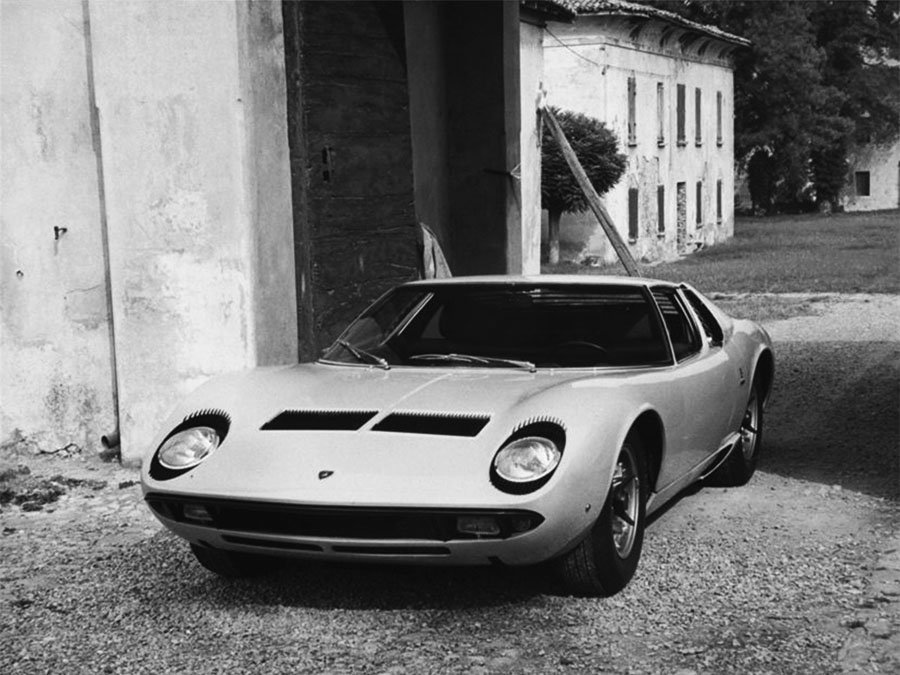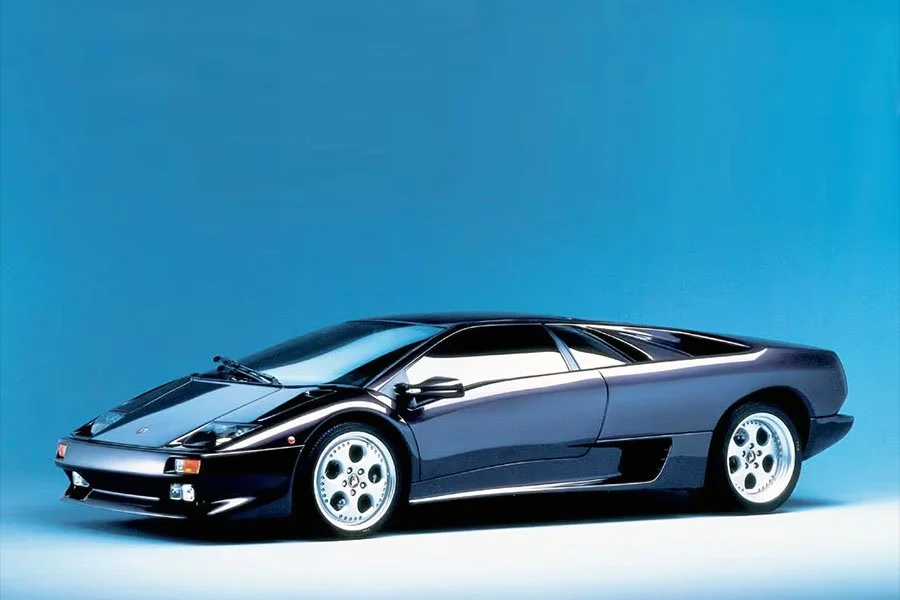Guide: Stoking the Fire - a Historical & Technical Appraisal of the Lamborghini Miura P400 S
/BACKGROUND
Although Ferruccio Lamborghini had originally planned to build the kind of conservatively-styled front-engined Grand Tourers that he and many other Italian industrialists liked to own, his talented group of engineers had other ideas.
While racing was clearly off limits, chief designer Gian Paolo Dallara, technical director Paolo Stanzani and chief test driver Bob Wallace secretly began work on a wild mid-engined road car.
Many evenings and weekends were spent formulating the design; finally, the team informed their boss about the hitherto undisclosed project in mid 1965. Fortunately, Ferruccio Lamborghini thought the new machine might serve as a useful marketing tool. The green light was given to proceed and a naked rolling chassis was displayed at the Turin Motor Show in November 1965.
Having caused a sensation, a completed car with bodywork by Bertone was presented at the Geneva Motor Show in March 1966.
Production of the new P400 Miura started a year later in March 1967. Sales took off immediately.
At the Geneva Motor Show in March 1968, Lamborghini added another extravagant Bertone-styled model to their range; the four-seat Espada was unlike anything else available and cemented Lamborghini’s reputation as builder of the wildest high performance cars available.
Alongside, the Espada, Lamborghini also launched the Islero at Geneva in ‘68 which was a conventional-looking front-engined 2+2 Coupe.
With their newly-expanded three-car line-up, no other manufacturer could match Lamborghini’s extraordinary array of models.
Meanwhile, work to improve the Miura was taking place in the background. The plan was to offer an uprated Miura S by the end of 1968.
At the heart of the Miura S was a more powerful engine. Other enhancements included improved suspension, the latest Pirelli Cinturato tyres and a higher specification cockpit.
Lamborghini debuted the Miura S at the Turin Motor Show in October ‘68. Although it had originally been conceived as an additional variant to sell alongside the existing Miura, the decision was quickly made to offer the S only.
Production began in December 1968.
CHASSIS
The Miura S used the 1mm gauge chassis that had been brought in to replace the original 0.9mm unit in January 1968. Most significantly, the rear suspension mounting points were now re-positioned to negate excessive squat under hard acceleration.
As usual, tubular steel subframes were attached at either end of the steel monocoque to support the engine, gearbox, suspension and other ancillary equipment.
The wheelbase was unchanged at 2500mm.
Chassis fabrication took place at Marchesi in Modena.
Suspension was via double wishbones, coil springs and telescopic dampers. Anti-roll bars were installed at either end.
Non servo-assisted Girling disc brakes ran off a separate hydraulic circuit for each axle. The front discs had a 305mm diameter while those at the rear measured 279mm.
Campagnolo centre-lock magnesium alloy wheels measured 15 x 7-inches all round and were shod with Pirelli’s latest generation Cinturato tyres.
A 90-litre fuel tank was installed over the front axle which enabled the designers to accommodate a decent-sized luggage bin at the back.
ENGINE / TRANSMISSION
In the engine bay was the most potent iteration of Lamborghini’s Giotto Bizzarrini-designed 60° V12 yet seen.
With its all-alloy construction, chain-driven dual overhead camshafts for each bank of cylindera and outstanding output figures, the Lamborghini V12 was arguably the finest high performance engine of its day.
For the Miura S, the engine’s combustion chambers were reshaped, the inlet ports were increased from 28mm to 30mm and high-lift camshafts were installed.
Additionally, the compression ratio was hiked from 9.5:1 to 10.7:1 and the four triple-choke downdraught Weber carburettors were switched from the original 40 IDL 3C type to the latest 40 IDL 3L.
Displacement was kept at 3929cc thanks to a bore and stroke of 82mm and 62mm respectively. Similarly, ignition was via a single spark plug per cylinder, two coils and two Marelli distributors.
Peak power went from 350bhp at 7000rpm to 370bhp at 7700rpm.
The torque rating went from 271lb-ft at 5100rpm to 287lb-ft at 5500rpm.
Transmission was via a five-speed Lamborghini transaxle with a single-plate clutch.
BODYWORK
Ferruccio Lamborghini had turned to Bertone after his favoured coachbuilder, Touring of Milan, began to encounter financial difficulties
The decision ultimately proved a good one as Bertone went on to design arguably Lamborghini’s most iconic models: the Miura, Espada and Countach.
The Miura was styled by Marcello Gandini who penned one of the most extraordinary looking automobiles of all time.
For the Miura S, only a couple of subtle alterations were made: the window frames were switched from black to chrome and an S script was added to the tail fascia.
Otherwise, all the Miura’s trademark features were retained: those retractable headlights mounted inboard of black slatted eyebrows, the upswept rear door sections with stacked engine cooling grilles, the six satin black slatted panels instead of a conventional fastback rear screen and the hexagonally-patterned tail grille.
The fuel filler cap was concealed underneath one of the slatted black grilles mounted mid-way up the front clip.
Bertone fabricated the single piece front and rear clamshells from aluminium. The doors, roof and centre section were steel.
Completed bodyshells were shipped from Turin to Sant’Agata for completion.
INTERIOR
Inside, Bertone made a number of changes to enhance comfort and practicality.
The short early type roof-mounted console was switched to a new full-length vented unit with half-a-dozen rocker-type instead of flick switches.
Electric windows were fitted as standard with the switches mounted at the front of the centre console ahead of the open-gate gear lever. Further back, the oddments tray behind the ashtray was given a lockable lid.
Smaller headrests were now fitted and the previously wooden steering wheel / gear knob were typically upholstered in leather.
The rest of the layout was the same as before.
Directly behind the three-spoke steering wheel was a 320kmh speedometer and a 10,000rpm rev counter. Each was housed in an individual cowl.
The rest of the instrumentation was located in an arced centre console that swept down to join the transmission tunnel. The half dozen additional gauges were stacked in two horizontal banks of three. Read outs for water temperature, oil temperature, oil pressure, fuel and battery condition were provided along with a clock.
OPTIONS
Air-conditioning was now available as an optional extra.
Customers could further enhance their car with full leather upholstery, special paint and interior finishes, a set of fitted luggage, three-point seat belts and a radio.
WEIGHT / PERFORMANCE
Weight was officially unchanged at 1293kg.
Thanks to the extra power and torque, performance figures were slightly improved.
Top speed went from 172mph to 176mph while the 0-62mph time dropped from 6 seconds to 5.9 seconds.
PRODUCTION CHANGES
Because the S was conceived to sell alongside the original 350bhp Miura, initially there was some crossover of production during the last two months of 1969. Thereafter, Lamborghini exclusively offered the Miura in S trim, initially alongside the Espada Series 1 / Islero S and later the Espada Series 2 / Jarama.
Although the Miura S was in production for just 18 months, Lamborghini made a number of changes to the specification.
Most importantly, ventilated discs brakes were added from April 1970 (chassis 4662, the 501st Miura built). The discs were once again imported from Girling and new pads were also fitted.
Other upgrades added during the course of 1970 included a more powerful alternator (770 watts instead of 450 watts), single instead of twin front and rear clip release mechanisms and constant velocity joints instead of splined driveshafts.
END OF PRODUCTION
Production of the Miura S ran from October 1968 to March 1971 when the further uprated SV was launched at Geneva.
338 examples were built of which 21 were right-hand drive.
Text copyright: Supercar Nostalgia
Photo copyright: Lamborghini - https://www.lamborghini.com



































